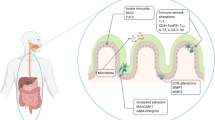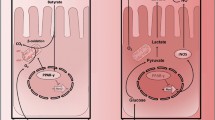Abstract
In previous studies, chemically induced colonic carcinomas were found to originate preferentially from crypts adjacent to lymphoid tissue. Proliferative parameters and mucosecretion were analyzed in proximal and distal rat colon in relation to the proximity of lymphoid patches. Animals received an intraperitoneal pulse of bromodeoxyuridine 1-hr before death. In both proximal and distal colon, crypts located at the immediate proximity of the lymphoid formations contained fewer mucous cells (P<0.001), but a higher percentage of proliferative epithelial cells (P<0.001) than the crypts far from lymphoid formations. The labeling index was higher in crypts adjacent to lymphoid patches compared to crypts distant from lymphoid patches only in the lower third of the crypts. The association of an increased proliferative activity and a decrease in differentiated mucosecreting cells in colonic crypts adjacent to lymphoid patches could be related to the particular sensitivity of these crypts cells to the effects of mutagens and carcinogens.
Similar content being viewed by others
References
Martin MS, Hammann A, Martin F: Gut-associated lymphoid tissue and 1,2-dimethylhydrazine intestinal tumors in the rat: An histological and immunoenzymatic study. Int J Cancer 38:75–80, 1986
Graham RC, Lundholm U, Karnovsky MJ: Cytochemical demonstration of peroxidase activity with 3-amino-9-ethylcarbazole. J Histochem Cytochem 16:150–152, 1965
Dixon WJ, Brown MB, Engelman L, Frane JW, Hill MA, Jennrich RI, Toporek JD: BMDP Statistical Software. Los Angeles, University of California Press, 1981
McGarrity TJ, Peiffer LP, Colony PC: Cellular proliferation in proximal and distal rat colon during 1,2-dimethylhydrazine-induced carcinogenesis. Gastroenterology 95:343–348, 1988
Deschner EE, Maskens AP: Significance of the labeling index and labeling distribution as kinetic parameters in colorectal mucosa of cancer patients and DMH treated animals. Cancer 37:1136–1141, 1982
Terpstra OT, Van Blankenstein M, Dees J, Eilers Guus AM: Abnormal pattern of cell proliferation in the entire colonic mucosa of patients with colon adenoma or cancer. Gastroenterology 92:704–708, 1987
Arai T, Kino I: Morphometrical and cell kinetic studies of normal human colorectal mucosa. Comparison between the proximal and the distal large intestine. Acta Pathol Jpn 39:725–730, 1989
Ferreira RC, Forsyth LE, Richman PL, Wells C, Spencer J, MacDonald TT: Changes in the rate of crypt epithelial cell proliferation and mucosa morphology induced by a T-cell-mediated response in human small intestine. Gastroenterology 98:1255–1263, 1990
Perera MIR, Kunz HW, Gill TJ, Shinozuka H: Enhancement of induction of intestinal adenocarcinomas by cyclosporine in rats given a single dose ofN-methylN-nitrosourea. Transplantation 42:297–302, 1986
Shimamoto F, Volmer E: Changes in intestinal mucosa above lymph follicles during carcinogenesis in rats. J Cancer Res Clin Oncol 113:41–50, 1987
Sharp JG, Crouse DA: Apparent synergism between radiation and the carcinogen 1,2-dimethylhydrazine in the induction of colonic tumors in rats. Radiat Res 117:304–317, 1989
Nauss KM, Locniskar M, Pavlina T, Newberne PM: Morphology and distribution of 1,2-dimethylhydrazine dihydrochloride-induced colon tumors and their relations to gutassociated lymphoid tissue in the rat. J Natl Cancer Inst 73:915–924, 1984
Deasy JM, Steale G, Ross DS, Lahey SJ, Wilson RE, Madara J: Gut-associated lymphoid tissue and dimethylhydrazine-induced colorectal carcinoma in the Wistar/Furth rat. J Surg Oncol 24:36–40, 1983
Bland PW, Britton DC: Colonic lymphoid tissue and its influence on tumour induction in dimethyl-hydrazine treated rats. Br J Cancer 44:275–276, 1981
Glickman LT, Suissa S, Fleiszner DM: Proliferative characteristics of colonic crypt cells in C57BL/6J and A/j mice as predictors of subsequent tumor formation. Cancer Res 47:4764–4770, 1987
O'Leary AD, Sweeney EC: Lymphoglandular complexes of the colon: Structure and distribution. Histopathology 10:267–283, 1986
Langman AD, Rowland R: The number and distribution of lymphoid follicles in the human large intestine. J Anat 194:189–194, 1986
Oohara T, Ogino A, Tohuma H: Microscopic adenomas in nonpolyposis coli: Incidence and relation to basal cells and lymphoid follicles. Dis Colon Rectum 24:120–126, 1981
Hillon P, Martin MS, Piard F, Jacquot JF: Relation between adenomas and colorectal-associated lymphoid tissue in familial polyposis coli. Dig Dis Sci 35:1307, 1990
Lee YS: Background mucosal changes in colorectal carcinomas. Cancer 61:1563–1570, 1988
Author information
Authors and Affiliations
Rights and permissions
About this article
Cite this article
Hammann, A., Arveux, P. & Martin, M. Effect of gut-associated lymphoid tissue on cellular proliferation in proximal and distal colon of the rat. Digest Dis Sci 37, 1099–1104 (1992). https://doi.org/10.1007/BF01300293
Received:
Revised:
Accepted:
Issue Date:
DOI: https://doi.org/10.1007/BF01300293




